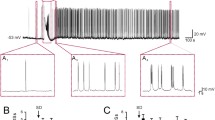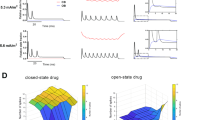Summary
The convulsant pentylenetetrazol (PTZ), 1% induces paroxysmal depolarization shifts (PDS) on regularly firing neurones ofHelix. Synaptic or antidromic stimulation or transmembrane current produces PDSs followed by a refractory period. For 5% of PTZ-treated neurons the membrane depolarizes up to −15 mV and PDS can be obtained by injected inward current.
In voltage clamp experiments the steadyi=f(V) characteristic of PTZ-treated neurons is N-shaped with a current flowing inwardly between −45 and −15 mV. The negative conductance is enhanced by warming and disappears at temperatures lower than 15°C. Besides, a slow triangular function (≦10 mV/sec) applied to the voltage clamp system indicates an important hysteresis in thei=f(V) curves according to the direction of swee**: depolarization or repolarization. From a hyperpolarized state (−70 mV) the stable point of the N-shapedi=f(V) characteristic is at −15 mV bringing the membrane potential to this level. From a depolarized state ≃10 mV) thei=f(V) characteristic shows no local negative slope and the stable point is at −45 mV bringing the membrane potential down to this level. PDSs correspond to the voltage transition between these two stable points. The amplitude of PDSs is directly related to the amplitude of hysteresis and their frequency to the kinetics of thei=f(V) characteristics. The different modes of activity under PTZ are explained by the position of thei=0 axis in relation with the region of negative resistance. It is suggested that increase of K+-inactivation by PTZ is the main phenomenon leading to a N-shaped characteristic.
Résumé
Le PTZ (1%) induit sur les neurones autoactifs d'Helix des ondes paroxysmales (O.P.) après une activité transitoire sur ondes lentes. La stimulation synaptique, antidrome ou par courant transmembranaire déclenche une O.P. suivie d'une période réfractaire. Dans 5% des cas le PTZ entraine un blocage de la membrane en plateau dépolarisé; des O.P. sont alors induites par un courant entrant.
En voltage imposé, la caractéristique stationnaire courant-voltage de la membrane traitée au PTZ présente une pente négative entre −45 et −25 mV qui augmente avec la température. L'utilisation de rampes de potentiel imposé de faible pente (≦10 mV/sec) montre d'autre part, une hystéresis des caractéristiquesi=f(V) selon le sens de parcours (dépolarisant ou hyperpolarisant). Par hyperpolarisation préalable, la caractéristiquei=f(V), du fait de la résistance négative présente un point stable vers −15 mV entrainant la dépolarisation de la membrane. Par dépolarisation préalable, la caractéristiquei=f(V) ne présente plus de pente négative et le point de stabilité est situé vers −45 mV, entrainant la repolarisation de la membrane. Les O.P. correspondent aux transitions du potentiel entre ces deux points de stabilité. Les différents modes d'activité sous PTZ sont explicités à partir de la position de l'axei=0 avec la zone à résistance négative. L'inactivation potassique par le PTZ serait la cause essentielle de l'induction d'une résistance négative stationnaire.
Similar content being viewed by others
Bibliographie
Araki, T., Otani, T.: Response of single motoneurons to direct stimulation in toad's spinal cord. J. Neurophysiol.18, 472–485 (1955)
Arvanitaki, A.: Plateaux de dépolarisation et trains paroxystiques de pointes en hyperthermie sur certains neurones identifiables d'Aplysia. C. R. Acad. Sci. (Paris)255, 1523–1525 (1962)
Arvanitaki, A., Chalazonitis, N.: Potentiels d'activité du soma neuronique géant (Aplysia). Arch. Sci. Physiol.9, 115–144 (1955)
Caspers, H., Speckmann, E. J.: Effect of pentylenetetrazol (PTZ) on single neurons ofHelix pomatia. IV. internat. Biophys. Congress, Moscou, IV, 247 (1972)
Chalazonitis, N., Ducreux, C., Arvanitaki, A.: Potentiels paroxystiques somatiques par action des convulsivants: signification fonetionnelle (neurones géants d'Helix). J. Physiol. (Paris)65, 212A (1972)
Chalazonitis, N., Takeuchi, H.: Amples oscillations du potentiel de membrane induites par le métrazol (neurones autoactifs d'Helix pomatia). C. R. Soc. Biol. (Paris)162, 1552–1556 (1968)
Creutzfeldt, O. D., Watanabe, S., Lux, H. D.: Relations between EEG phenomena and potentials of single cortical cells. II. Spontaneous and convulsoid activity. Electroenceph. clin. Neurophysiol.20, 19–37 (1966)
David, R. J., Wilson, W. A., Escueta, A. V.: Voltage clamp analysis of pentylenetetrazol effects onAplysia neurons. Brain Res.67, 549–554 (1974)
Ducrcux, C., Takeuchi, H., Chalazonitis, N.: Depolarisation paroxysmale du soma et décharges axoniques d'un même neurone traité au métrazol (neurones autoactifs d'Helix). C. R. Acad. Sci. (Paris)275, 1907–1909 (1972)
Eckert, R., Lux, H. D.: A non inactivating inward current recorded during small depolarizing voltage steps in smail pace-maker neurones. Brain Res.83, 486–489 (1975)
Faber, D. S., Klee, M. R.: Bursting behavior evoked inAplysia neurons by pentylenetetrazo. Pflügers Arch.332 R66 (1972)
Faugier, S., Willows, A. O. D.: Behavioral and nerve cell membrane effects of an epileptic agent (metrazol) in a mollusk. Brain Res.52, 243–260 (1973)
Faugier-Grimaud, S.: Extrasynaptic mechanisms of cardiazol induced epileptiform activity of invertebrate neurons. Brain Res.69, 354–360 (1974)
Frazier, W. T., Kandel, E. R., Kupfermann, L., Waziri, R., Coggeshall, R. E.: Morphological and functional properties of identified neurons in the abdominal ganglion ofAplysia californica. J. Neurophysiol.30, 1288–1351 (1967)
Gola, M.: La conductance potassique des neurones d'Helix en relation avec la rectification anomale. C. R. Acad. Sci. (Paris)274, 1579–1582 (1972)
Gola, M.: Neurones à ondes-salves des Mollusques. Variations cycliques lentes des conductances ioniques. Pflügers Arch.352, 17–36 (1974)
Gola, M., Romey, G.: Réponses anomales à des courants sousliminaires de certaines membranes somatiques (neurones géants d'Helix pomatia). Pflügers Arch.327, 105–131 (1971)
Gola, M., Romey, G.: Les oscillations lentes du P. M. de certains neurones d'Aplysia. Existence d'une caractéristique I. V. stationnaire à pente négative. J. Physiol. (Paris)67, 227 (1973)
Klee, M. R., Faber, D. S.: Endogenous mechanisms underlying membrane potential oscillations in burstingAplysia neurons. In: Central rhythmic and regulation. Umback and Koepchen, eds., pp. 58–68. Stuttgart. Hypokates 1974
Klee, M. R., Faber, D. S., Heiss, W. D.: Strychnine and pentylenetetrazole induced changes of excitability inAplysia neurons. Science179, 1133–1136 (1973)
Matsumoto, H., Ajmone-Marsan, C.: Cortical cellular phenomena in experimental epilepsy: interictal manifestations. Exp. Neurol.9, 286–304 (1964)
Noble, D.: Application of Hodgkin-Huxley equations to excitable tissues. Physiol. Rev.46, 1–50 (1966)
Oakley, J. C., Sypert, G. W., Ward, A. A. Jr.: Conductance changes in neocortical propagated seizure: seizure initiation. Exp. Neurol.37, 287–299 (1972)
Smith, T. G., Barker, J. L., Gainer, H.: Requirements for bursting pacemakers potential activity in molluscan neurones. Nature (Lond.)253, 450–452 (1975)
Speckmann, E. U., Caspers, H.: Paroxysmal depolarization and changes in action potentials induced by pentylenetetrazol in isolated neurons ofHelix pomatia. Epilepsia14, 397–408 (1973)
Sugaya, E., Goldring, S., O'Leary, J. L.: Intracellular potentials associated with direct cortical response and seizure discharge in cat. Electroenceph. clin. Neurophysiol.17, 661–669 (1964)
Sugaya, A., Sugaya, E., Tsujitani, M.: Pentylenetetrazol induced intracellular potential changes of the neuron of the japanese land snailEuhadra peliomphala. Jap. J. Physiol.23, 261–274 (1973)
Takeuchi, H., Chalazonitis, N.: Effets du phénobarbital sur les neurones autoactifs. C. R. Soc. Biol. (Paris)162, 491–497 (1968)
Tauc, L.: Les divers modes d'activité du soma neuronique ganglionnaire de l'Aplysie et de l'Escargot. In: Microphysiologie Comparée des Eléments excitables, no 67, Coll. internat. CNRS, Ed. du CNRS, Paris 1955
Wachtel, H., Wilson, W. A.: Voltage clamp analysis of rhythmic slow wave generation in bursting neurons. In: Neurobiology of Invertebrate. Salanki, ed., Publ. House of Hungarian Acad. Sci., Budapest, pp. 59–80 (1973)
Washizu, Y., Bonewell, G. W., Terzuolo, C. A.: Effect of strychnine upon the electrical activity of an isolated nerve cell. Science133, 333–334 (1961)
Wilson, W. A., Wachtel, H.: Negative resistance characteristic essential for the maintenance of slow oscillations in bursting neurons. Science186, 932–934 (1974)
Author information
Authors and Affiliations
Rights and permissions
About this article
Cite this article
Ducreux, C., Gola, M. Ondes paroxysmales induites par le métrazol (PTZ) sur les neurones d'Helix p.: Modèle fonctionnel. Pflugers Arch. 361, 43–53 (1975). https://doi.org/10.1007/BF00587338
Received:
Issue Date:
DOI: https://doi.org/10.1007/BF00587338




